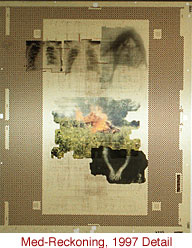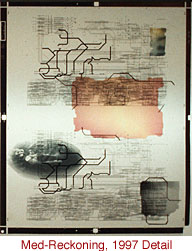It is at once playful and foreboding. Over seven feet in length, a strange form hovers mid-air, moving only slightly in the current of curious viewers stepping in for a closer look. The delicate, netted barb cuts through the room; its bright yellow tip spiraling downward. At the center, a diaphanous skin of nylon stretches over an arterial mass of meshed plastic, translucent blue and yellow show through taut, maroon fabric. From the core, a tail of orange cones appears to whip through space, as if propelling this creature about the gallery.
The piece, Receptor 2, is part of a recent body of work by Brooklyn artist, Margie Neuhaus, entitled Sensory Jetty. The colorful series – as much drawing as sculpture – is both familiar and un-nameable. A divide between knowing and not-knowing runs through the center of Neuhaus’s work, but it is a transmutable barrier that allows glimpses from both sides. Through transparent collage and constructed sculpture, the artist creates airy forms that could just as easily reference creatures of the deep sea as the inner workings of the human body. The pieces – simultaneously fragile and powerful – speak of the inherent complexities of organic life. Merging memory, science and imagination, Neuhaus explores the wondrous yet flawed systems of life and death.
Like the biological organisms that inspire it, Margie Neuhaus’s art feeds off its surroundings. The materials themselves are often store-bought though not traditional art supplies. Plastic netting from a lobster trap, translucent vellum from a stationers shop, scavenged electrical cord; the artist gathers manufactured detritus from daily life and renders it unrecognizable. The distance between a material and its original function is important for her to maintain. At times, when she is unable to alter an object enough to obscure its original associations, Neuhaus replicates the pattern out of a different material altogether, creating mesh by individually punching holes in plastic, or weaving netting out of synthetic twine. The time-intensive process brings plastic to life, creating forms that are biomorphic but not biodegradable.
In contrast to her synthetic materials, the process of creation is truly organic. The work within Sensory Jetty - although inspired by nature - is dictated by intuitive process of discovery and experimentation. Although she begins with a strong idea of what the artwork might be, the process itself often necessitates change. Allowing for that departure, Margie Neuhaus often finds her work heading directions she had not anticipated.
 As the work spreads into new territory, it also doubles-back to revisit earlier ideas. The current series grows out of an earlier installation investigating ideas of the body in a medical context; Med-Reckoning is a sculptural environment that combines x-rays, circuit-boards, and architectural photographs. In the piece, Neuhaus explores the complex act of viewing something that is usually hidden. She asks us to consider what it means to look into our own body… to be removed from an image to which we are physically bound. The complexity of the visual politics is intriguing. An x-ray is tangible proof of the mysterious workings of your body, a glimpse from the outside in. “When you can see inside yourself, it’s an interesting position. You are both subject and object.” As the work spreads into new territory, it also doubles-back to revisit earlier ideas. The current series grows out of an earlier installation investigating ideas of the body in a medical context; Med-Reckoning is a sculptural environment that combines x-rays, circuit-boards, and architectural photographs. In the piece, Neuhaus explores the complex act of viewing something that is usually hidden. She asks us to consider what it means to look into our own body… to be removed from an image to which we are physically bound. The complexity of the visual politics is intriguing. An x-ray is tangible proof of the mysterious workings of your body, a glimpse from the outside in. “When you can see inside yourself, it’s an interesting position. You are both subject and object.”
Navigating between image and self is an apt metaphor for the creative process, one that is reinforced by the title of Med-Reckoning. It alludes to the phrase ‘dead reckoning’ in which navigation is charted by relying on a set point (or ‘fix’.) Dead  reckoning is a somewhat antiquated nautical technique, seldom used today because of its potential for error– the ‘fix’ must be certain or else all of the calculations will be off. In setting a course, the traveler must have faith in an intangible starting point: be it a star or a distant mountaintop. reckoning is a somewhat antiquated nautical technique, seldom used today because of its potential for error– the ‘fix’ must be certain or else all of the calculations will be off. In setting a course, the traveler must have faith in an intangible starting point: be it a star or a distant mountaintop.
In 1992, Margie Neuhaus found an unlikely parallel within the white walls of the hospital. She was there with her mother who had recently been diagnosed with cancer. Over the ensuing months, her attempt to navigate the medical world often led to confusion. While the doctors set a course of action based on a particular constellation of symptoms, trusting patients, like her mother, were left floating in the dark with only belief to guide them. At times it was unclear if they were even headed in the right direction.
The sense of faltering optimism in the face of fallibility is continued within the Sensory Jetty series. Often stitched together with the thinnest of nylon thread, the collages and sculptures embody a paradoxical balance. They are simultaneously exposed and protected, fragile and aggressive. The brightly colored shapes weave delicate webs of interdependence. Each piece functions as both sculpture and drawing. The collages suggest spatial depth through layering and transparency; the sculptures draw through the air, creating graphic strokes of colored line.
The work inhabits the gallery space tangibly. Viewers walk in and around the delicate forms, careful not to brush up against their spiky appendages. The dance is one of acute physical awareness, the kind of attention normally reserved for handling infants or sharp instruments. Vulnerable yet dangerous, the small, suspended sculpture, Receptor 1, floats like a man-made jellyfish overhead. Its ethereal beauty becomes suspect; these seemingly flimsy creatures can be poisonous. Upon closer inspection, the soft curves of the skirted form reveal metallic barbs sharp enough to cut, its underbelly a collection of nodes and wires perhaps ready to shock. The urge to touch is out-balanced by doubt; its beauty counteracted by fear.
The discord between visual pleasure and apprehension is commonplace in the animal kingdom, where vivid coloring is not just an enticement but also a warning to potential predators. There exists a connection between these two abstract ideas – beauty and death – despite their forced distance in our thoughts. The conflicted connection became apparent to Margie Neuhaus during her mother’s cancer treatment. “ I would go to the tests with her and see these really beautiful shapes on the results. But I knew the shapes meant something bad.” Eventually losing her mother to the disease, she created Med-Reckoning as a way of working through the absence and addressing the fears generated by her interaction with the medical system. Instead of focusing on the specificity of her personal tragedy, she addressed the complexities of coping with illness in broad terms – allowing for both beauty and pain, decay and regeneration.
Recognizing the relationship between the personal and political can be a matter of scale. In Margie Neuhaus’s artwork, the macrocosm and the microcosm intertwine. In a world where the smallest cells can wreak havoc and the largest creatures can prove benign, point of view is everything. From a distance, the machinations of life can contain all of the wonder of her creations: beauty, fear, color and even humor. Up close, the intricate designs still obscure pointed barbs, even if you know to look for them.
Sensory Jetty was on view at SafeTGallery in the DUMBO section of Brooklyn, January 25th through February 24, 2007.
Enter the Gallery >

|
